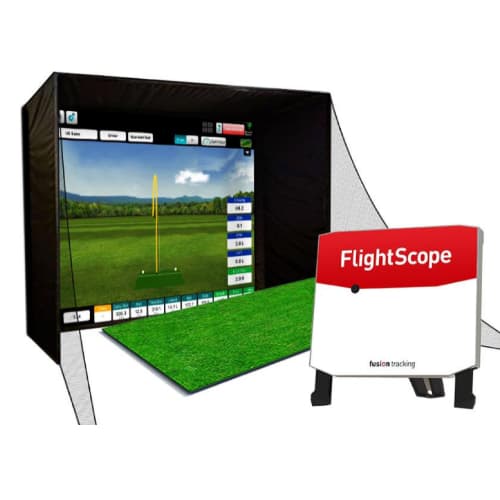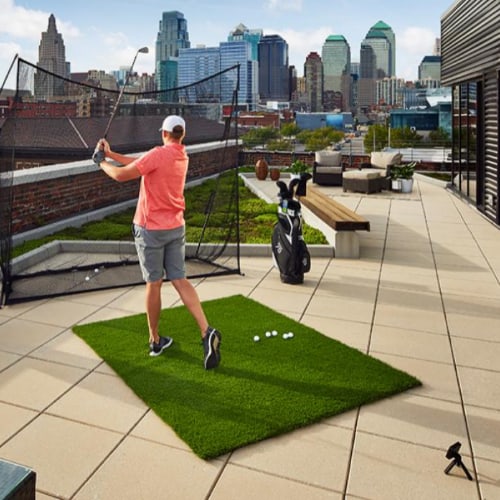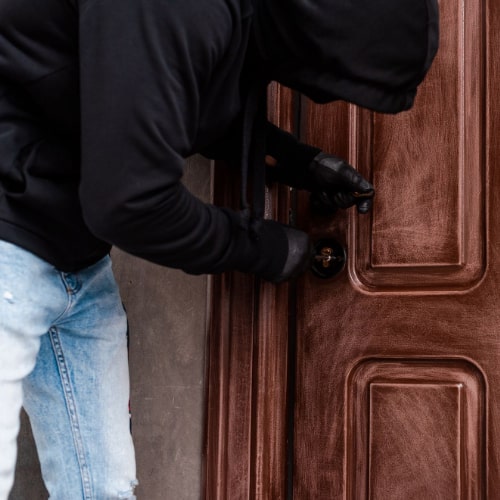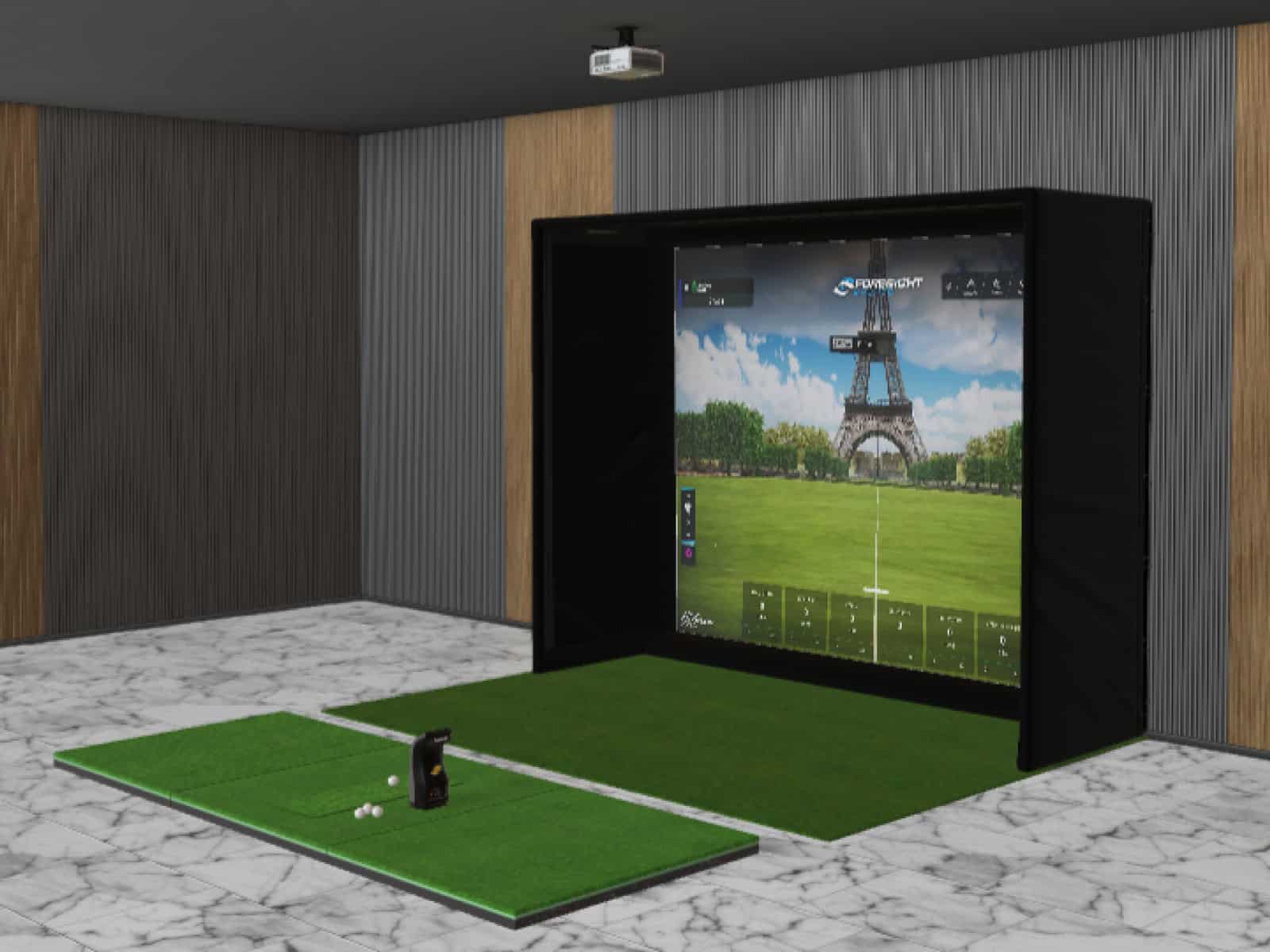Golf simulators have become a popular choice among golf enthusiasts and professionals alike. These advanced systems allow you to practice your swing, play virtual courses, and even compete with others without leaving the comfort of your home.
With the growing trend of outdoor living spaces, many are wondering if it’s possible to set up a simulator outside. In this article, we’ll explore the feasibility, benefits, and challenges of having an outdoor simulator, as well as provide tips for installation and maintenance.
Understanding Golf Simulators
A golf simulator is a system that replicates the experience of playing golf on a real course. It typically consists of a projector, screen, sensors, and software (running on a PC or smart device).

The projector displays a virtual course on the screen, while the sensors track the club’s movements and the ball’s trajectory.
The software then analyzes the data and provides feedback on your performance, displayed directly on the screen or your connected smart device.
Golf simulators can be used for practice, entertainment, or even professional training.
Can You Put a Golf Simulator Outside?
Yes, you can set up a simulator outside, but there are several factors to consider, including weather conditions, space requirements, and equipment protection.
It’s important to choose the right technology for outdoor use, as some simulators are affected by light and may not perform well outdoors.

Portability and endurance are also important, as some systems are more suitable for outdoor use than others.
If you plan to use a projector, make sure it’s installed in a covered area and protected from the elements.
Regular maintenance and care are essential to ensure the longevity of any outdoor simulator.
You will also find our guide on the best golf simulator for outdoor use helpful.
Benefits of Having an Outdoor Golf Simulator
Setting up a simulator outside offers several advantages.
First, it provides more room for you to move around and swing freely. This is especially beneficial for those with limited indoor space.
Second, an outdoor package allows you to enjoy natural light and fresh air while playing. It can also be a great addition to a backyard, patio, or garden, enhancing the overall design of the outdoor living area.
Moreover, an outdoor system can be a simple and cost-effective DIY project, or it can be an ultimate, high-end setup with all the bells and whistles.
Challenges of Setting Up an Outdoor Golf Simulator
Despite the benefits, there are several challenges to consider when setting up an outdoor system.
Weather conditions, such as rain, wind, and snow, can affect the performance and longevity of the equipment.
Space requirements may also be an issue, as a simulator needs a certain amount of space for the hitting area, screen, and other components.
Additionally, protecting the equipment from theft, vandalism, and environmental factors is crucial. All these things can add up to the initial investment, so bear them in mind.
Weather Considerations
Weather is a significant factor to consider when setting up an outdoor simulator.

Rain, wind, and snow can damage the equipment and affect its performance. To protect the golf simulator from adverse weather conditions, consider using weather-resistant materials, covers, or temporary shelters.
For example, an inflatable golf simulator enclosure can provide protection from the elements while allowing for easy setup and storage.
Alternatively, a pergola, shed, or gazebo can offer a more permanent solution. If the golf simulator is set up near a pool house or garden room, it may be possible to move the equipment inside during bad weather. All these precautions will protect your investment from the elements. You also need to ensure they are not destroyed by extreme heat, cold or humidity.
Space Requirements
Space is another important consideration for an outdoor simulator.
The hitting area, screen, and other components require a certain amount of room. To optimize the available space, consider the layout and design of the outdoor area.
For example, a patio or garden may provide enough room for a simple simulator setup, while a larger backyard may accommodate a more elaborate setup with furniture, a bay, and other amenities.
If space is limited, a portable simulator may be a better option, as it can be easily moved and stored when not in use.
Equipment Protection
Protecting the simulator’s components from theft, vandalism, and environmental factors is essential.
Security measures, such as locking mechanisms and surveillance cameras, can help deter potential thieves.

Proper storage is also important, especially for portable or inflatable golf simulators. Consider using a shed, cabin, or simulator shed to store the equipment when not in use.
If the simulator is set up in a garden room or near a pool house, it may be possible to store the equipment inside.
Technology for Outdoor Use
Simulator technology is crucial for outdoor use, as different technologies perform differently outdoors.
Infrared simulators, like Optishot 2, are affected by light and should be avoided outdoors.
Photometric simulators with high-speed cameras, such as Skytrak and Foresight Sports GC series, work both indoors and outdoors, but cameras should not be in direct sunlight.
Radar Doppler launch monitors, including Trackman, Full Swing, FlightScope, and Garmin Approach R10, are best for outdoor use, requiring more ball flight distance and providing accurate data. Just ensure you have at least 16′ to 18′ of space between the position of the radar-based launch monitor and the hitting screen or net to provide enough ball flight distance for accurate readings.
Portability & Endurance
Simple systems with a monitor, hitting net, and golf mat are ideal for outdoor use. A full enclosure with a projector and screen is less portable and usable outdoors.
Some packages, like the Skytrak Bronze Simulator Package, include both indoor and outdoor components. Some systems, such as the Cimarron Masters Golf Net Enclosure, can withstand tough weather conditions and may be installed outside all year.
Projector or No Projector?
Adding a projector outdoors adds installation challenges.
A floor mount mechanism is recommended for projectors outdoors. They should be installed in a covered area with a ceiling and preferably walls.
Image quality and brightness are reduced during daylight; a powerful and bright laser projector with a minimum of 4,000 lumens is recommended.
Using a projector/screen combo outdoors is more challenging than using a hitting net and checking data on a laptop or smart device.
Generally speaking, it is more convenient to use the screen and projector indoors and the net and launch monitor outdoors.
Installation Tips
Installing an outdoor simulator requires careful planning and consideration.

Start by selecting a suitable site for the simulator, taking into account the available space, weather conditions, and security measures.
Next, install the equipment, including the projector, screen, sensors, and software.
Calibration is crucial for accurate results, so follow the manufacturer’s instructions carefully.
If the simulator is set up in a tent, pergola, or gazebo, make sure the structure is stable and provides adequate protection from the elements.
Maintenance and Care
Regular maintenance and care are essential for the longevity of an outdoor simulator.
Clean the equipment regularly to remove dirt, dust, and debris.
Calibrate the sensors and software as needed to ensure optimal accuracy.
Protect the equipment from adverse weather conditions and store it properly when not in use.
If the simulator is set up in an enclosure, make sure the enclosure is in good condition and provides adequate protection.
Frequently Asked Questions
Let’s now answer some of the most frequently asked questions related to outdoor simulator placement.
Can I rent a golf simulator for my backyard?
Yes, many companies offer golf simulator rental for events or temporary use. This can be a great option for those who want to try out a simulator before purchasing one or for special occasions.
Can I set up a golf simulator in my garden room?
Yes, a garden room can be an ideal location for a simulator, as it provides protection from the elements while allowing for natural light and fresh air. Just make sure the room is large enough to accommodate the equipment and your swing.
What is the best brand of golf simulators for outdoor use?
The best brand of golf simulator for outdoor use depends on your specific needs and preferences. Radar Doppler launch monitors, such as TrackMan, Full Swing, FlightScope’s Mevo+ and X3, and Garmin Approach R10, are generally considered the best for outdoor use.
These systems require more ball flight distance and provide accurate data, making them ideal for outdoor settings.
Technology has allowed modern high-end photometric launch monitors to be (almost) as accurate outdoors as indoors. Excellent options like Uneekor’s EYE MINI, Flightscope GC3 and GCQuad, and Skytrak + will all work well outdoors.
These are all great options to consider; however, it’s important to bear other factors in mind, such as portability, endurance, and budget, when choosing a simulator for outdoor use.
Conclusion
Having an outdoor golf simulator can be a great addition to any outdoor living space. It offers the benefits of more room, natural light, and fresh air while playing.
However, there are several challenges to consider, including weather conditions, space requirements, and equipment protection. By carefully planning the installation and maintenance of the simulator, it’s possible to enjoy the benefits of an outdoor simulator for years to come.
We hope our tips will help you build your dream outdoor system. If you have any questions, feel free to contact us via email or in the comments section below.





